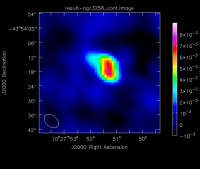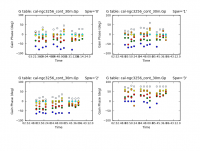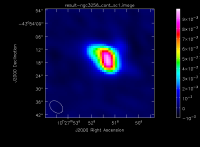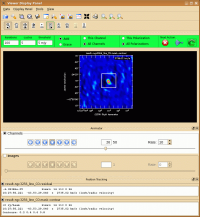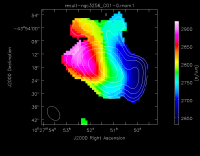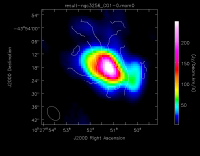NGC3256 Band3 - Imaging for CASA 3.3
Overview
This portion of the NGC3256Band3 CASA Guide will cover the imaging of the continuum and spectral line data. It begins where the NGC3256 Band3 - Calibration section left off: right after running the CASA task split to split off the science target from the rest of the measurement set following calibration. If you completed the Calibration section of the guide, then you can continue where you left off, with ngc3256_line_target.ms. If you did not complete the Calibration portion of the guide, then you can download the calibrated file containing only the science target here:
[LINK]
Once the download has finished, unpack the file:
# In a terminal outside CASA
tar -xvzf ngc3256_line_target.ms.tgz
Continuum image of the galaxy
We will start by making a continuum image of the galaxy using clean. Since this dataset contains spectral line emission from both CO and CN, we are careful to select only the channels that are free of line emission. We select a mask that just includes the extent of the continuum emission. Here, we use the default non-interactive mode, but if you want to define the clean boxes more carefully, specify interactive=True. In that case, the clean task will bring up a viewer where the clean region can be defined, either by selecting boxes or by selecting polygon regions.
# In CASA
os.system('rm -rf result-ngc3256_cont*')
clean( vis='ngc3256_line_target.ms', imagename='result-ngc3256_cont',
spw='0:20~53;71~120,1:70~120,2:20~120,3:20~120', psfmode='hogbom',
mode='mfs', niter=500, threshold='0.3mJy', mask=[120,121,137,138],
imsize=256, cell='1arcsec', weighting='briggs', robust=0.0,
interactive=False)
The input parameters include:
- vis='ngc3256_line_target.ms': The calibrated dataset on the science target
- imagename='result-ngc3256_cont': The base name of the output images
- spw='0:20~53;71~120,1:70~120,2:20~120,3:20~120': To specify only the channels in each spw free of line emission
- psfmode='hogbom': The method used to calculated the PSF during minor clean cycles. Hogbom is a good choice for poorly-sample uv-planes
- mode='mfs': The default mode, which produces one image from all the specified data combined
- niter=1000: Maximum number of clean iterations
- theshold='0.3mJy': Stop cleaning if the maximum residual is below this value. We choose the threshold to be ~1.5 times the rms noise in the image
- mask=[120,121,137,138]: Limits the clean component placement to the region of the source
- imsize=256, cell='1arcsec': Chosen to appropriately sample the resolution element and cover the primary beam
- weighting='briggs', robust=0.0: a weighting scheme that offers a good compromise between sensitivity and resolution
Again, we determine some statistics of the image:
# In CASA
calstat=imstat(imagename='result-ngc3256_cont.image', region='', box='160,50,210,210')
rms=(calstat['rms'][0])
print '>> rms in continuum image: '+str(rms)
calstat=imstat(imagename='result-ngc3256_cont.image', region='')
peak=(calstat['max'][0])
print '>> Peak in continuum image: '+str(peak)
print '>> Dynamic range in continuum image: '+str(peak/rms)
This tells us that the peak flux density of the image is ~7 mJy and the dynamic range is approximately 30. For future reference, we create a png file of the continuum image:
# In CASA
imview(raster={'file': 'result-ngc3256_cont.image', 'colorwedge':T,
'range':[-0.001, 0.007], 'scaling':0, 'colormap':'Rainbow 2'},
out='result-ngc3256_cont.png', zoom=2)
The continuum flux is fairly low in this galaxy, but given the large bandwidth of ALMA, we have sufficient signal-to-noise to attempt to self-calibrate the data. We will therefore do some phase-only self-calibration of the image using the task gaincal. This will compare the data column with the model column, which has been filled with the clean components from the recent run of clean. We use a solution interval of 30 minutes as we found that this gives just sufficient signal to noise per baseline. Using the ALMA sensitivity calculator, we estimate that the rms noise level per baseline, for 30 min integration time and a total bandwidth of 5.1 GHz (excluding the emission lines), is 0.7 mJy. Compared to the peak flux of ~7 mJy, this should give us sufficient SNR, taking into account that the emission is slightly resolved.
# In CASA
gaincal(vis='ngc3256_line_target.ms', field='NGC*',
caltable='cal-ngc3256_cont_30m.Gp',
spw='0:20~53;71~120,1:70~120,2:20~120,3:20~120',
solint='1800s', refant='DV04', calmode='p',
minblperant=3)
- caltable='cal-ngc3256_cont_900.Gp': The name of the output calibration table
- spw='0:20~53;71~120,1:70~120,2:20~120,3:20~120': To select only the continuum channels
- solint='1800s': To specify a 30-minute solution interval
- refant='DV04': Our reference antenna
- calmode='p': To select phase-only solutions
- minblperant=3: To set the minimum number of baselines to other antennas that must be present for a given antenna to have a solution
We then examine the derived phase solutions using plotcal:
# In CASA
plotcal(caltable = 'cal-ngc3256_cont_30m.Gp', xaxis = 'time', yaxis =
'phase', poln='X', plotsymbol='o', plotrange = [0,0,-180,180],
iteration = 'spw', figfile='cal-phase_vs_time_XX_30_Gp.png',
subplot = 221)
plotcal(caltable = 'cal-ngc3256_cont_30m.Gp', xaxis = 'time', yaxis =
'phase', poln='Y', plotsymbol='o', plotrange = [0,0,-180,180],
iteration = 'spw', figfile='cal-phase_vs_time_YY_30_Gp.png',
subplot = 221)
The phase-only self-cal solutions look good, so we will apply them to the data with applycal. This will overwrite the data in the corrected_data column.
# In CASA
applycal(vis='ngc3256_line_target.ms', interp='linear',
gaintable='cal-ngc3256_cont_30m.Gp')
We then make another continuum map from the newly-corrected data, using the same clean parameters as before.
# In CASA
os.system('rm -rf result-ngc3256_cont_sc1*')
clean( vis='ngc3256_line_target.ms', imagename='result-ngc3256_cont_sc1',
spw='0:20~53;71~120,1:70~120,2:20~120,3:20~120', psfmode='hogbom',
mode='mfs', niter=500, threshold='0.13mJy', mask=[120,121,137,138],
imsize=256, cell='1arcsec', weighting='briggs', robust=0.0,
interactive=False)
and again generate some statistics:
# In CASA
calstat=imstat(imagename='result-ngc3256_cont_sc1.image', region='', box='160,50,210,210')
rms=(calstat['rms'][0])
print '>> rms in continuum image: '+str(rms)
calstat=imstat(imagename='result-ngc3256_cont_sc1.image', region='')
peak=(calstat['max'][0])
print '>> Peak in continuum image: '+str(peak)
print '>> Dynamic range in continuum image: '+str(peak/rms)
The continuum image has improved a lot. The dynamic range is now ~100, whereas before it was only ~30. The image peak flux density is ~9 mJy. We will write this new image to the file 'result-ngc3256_cont_sc1.image' to indicate that an iteration of self-calibration was performed. We also create a new png file of the self-calibrated continuum image.
# In CASA
imview(raster={'file': 'result-ngc3256_cont_sc1.image', 'colorwedge':T,
'range':[-0.001, 0.007], 'scaling':0, 'colormap':'Rainbow 2'},
out='result-ngc3256_cont_sc1.png', zoom=2)
In principle, one could experiment further with self-calibration, changing the solution interval, or even do an amplitude self-calibration. To do this, just repeat the steps gaincal, applycal, and clean until you are happy with the result. For the moment, we are happy with just one round of phase-only self-cal.
Line cubes of the galaxy
We will start by running split to apply the latest self-calibration tables to the data column of the output measurement set.
# In CASA
os.system('rm -rf ngc3256_line_target_sc.ms*')
split(vis='ngc3256_line_target.ms', outputvis='ngc3256_line_target_sc.ms')
We will then subtract the continuum using the task uvcontsub:
# In CASA
uvcontsub(vis = 'ngc3256_line_target_sc.ms',
fitspw='0:20~53;71~120,1:70~120,2:20~120,3:20~120', solint ='inf',
fitorder = 1, fitmode = 'subtract')
- fitspw='0:20~53;71~120,1:70~120,2:20~120,3:20~120': To specify the spectral windows and channels to be used in the fit for the continuum. We avoid the spectral regions that include the CO and CN emission lines.
- solint ='inf': Timescale for the fit. Here we are electing to have one fit per scan
- fitorder = 1: We will fit a first-order polynomial to the continuum
- fitmode = 'subtract': Subtract the continuum from the data and store the result in the corrected_data column
Next, we will clean the CO (1-0) line emission:
# In CASA
os.system('rm -rf result-ngc3256_line_CO.*')
clean(vis='ngc3256_line_target_sc.ms', imagename='result-ngc3256_line_CO',
spw='0:48~78', mode='channel', start='', nchan=31, width='', psfmode='hogbom',
outframe='LSRK', restfreq='115.271201800GHz', mask=[53,50,87,83],
niter=500, interactive=T, imsize=128, cell='1arcsec',
weighting='briggs', robust=0.0, threshold='15mJy')
Notable parameters include:
- spw='0:48~78': To specify the CO (1-0) line emission alone
- mode='channel': To produce an image with different planes specified by the "start", "nchan", and "width" parameters
- start=, nchan=31, width=: To include all 31 channels specified by spw, with no channel averaging
- threshold='15 mJy': Stop cleaning if the maximum residual is below this value.
- outframe='LSRK': Shift the output reference frame to the local standard of rest
- restfreq='115.271201800GHz': The rest frequency of the CO line
- mask=[53,50,87,83]: The region in which to fit clean components (i.e., the source)
- niter=500, interactive=T: To do interactive cleaning with the viewer GUI
- psfmode='hogbom': The method used to calculated the PSF during minor clean cycles. Hogbom is a good choice for poorly-sample uv-planes
Note that you can also find the frequencies of many spectral lines inside CASA. For example, the following commands will search for CO emission lines in ALMA band 3, and output the results to the logger:
# In CASA
slsearch(outfile="myresults.tbl", freqrange = [84,116], species=['COv=0'])
sl.open('myresults.tbl')
sl.list()
Or define the parameter restfreq directly using:
# In CASA
tb.open('myresults.tbl')
restfreq=tb.getcol('FREQUENCY')[0]
Using interactive=T the viewer will open when it is ready to start an interactive clean. Step through to the channels to see how extended the emission is. Then either use "All Channels" to define the same clean mask for all channels or select "This Channel" to select different masks for each channel. Once you have defined a polygon region, you need to double click inside it to save the mask region. You can use the "tape deck" to step through the channels again and check that the emission in all channels fits within the mask(s) you have created. Note that the mask we defined above does not include all emission -- you will have to change the mask interactively! To continue with clean use the "Next action" buttons in the green area on the Viewer Display GUI: The red X will stop clean where you are, the blue arrow will stop the interactive part of clean, but continue to clean non-interactively until reaching the stopping niter or threshold (whichever comes first), and the green arrow will clean until it reaches the "iterations" parameter on the left side of the green area.
When the cleaning has finished, you may want to inspect the resulting cube and and use the tape deck to play the cube as a movie. Use Spectral Profile in the Tools tab to make an integrated spectrum of the CO(1-0) emission.
# In CASA
imview('result-ngc3256_line_CO.image')
The rms noise level in the cube is XXX mJy per channel. The ALMA sensitivity calculator gives a noise level of XXX mJy, using 7 antennas and an integration time of 3.5 hours....
Next, we make the moment maps of the CO (1-0) emission using the task immoments:
# In CASA
os.system('rm -rf result-ngc3256_CO1-0.mom.*')
immoments(imagename='result-ngc3256_line_CO.image', moments=[0,1],
chans='5~24', box='38,38,90,90', axis='spectral',
includepix=[0.045, 10000], outfile='result-ngc3256_CO1-0.mom')
- moments=[0,1]: To specify that we wish to make the 0th and 1st moment maps; that is, the integrated emission map and the intensity-weighted velocity field
- chans='5~24': These are the channels that show line emission and therefore the ones we want to use for the moment map
- box='38,38,90,90': To select a box region around the emission so as to not include any regions away from the galaxy
- axis='spectral': Indicates the moment axis; in this case, 'spectral'
- includepix=[0.045, 10000]: To select which pixel values in the cube to include in the moments. We find these values by looking for the faintest believable emission in the cube
- outfile='result-ngc3256_CO1-0.mom': The output image base name
[NEED TO SAY SOMETHING ABOUT OUTPUT]
Make images of the CO(1-0) emission
# In CASA
imview(contour={'file': 'result-ngc3256_CO1-0.mom.integrated','range': []},
raster={'file': 'result-ngc3256_CO1-0.mom.weighted_coord','range': [2630,2920],'colorwedge':T,
'colormap': 'Rainbow 2'}, out='result-CO_velfield.png')
# In CASA
imview(contour={'file': 'result-ngc3256_CO1-0.mom.weighted_coord','levels':
[2650,2700,2750,2800,2850,2900],'base':0,'unit':1},
raster={'file': 'result-ngc3256_CO1-0.mom.integrated', 'colorwedge':T,
'colormap': 'Rainbow 2'}, out='result-CO_map.png')
Next, we clean the CN high line emission:
# In CASA
os.system('rm -rf result-ngc3256_line_CNhi.*')
clean(vis='ngc3256_line_target_sc.ms', imagename='result-ngc3256_line_CNhi',
outframe='LSRK', spw='1:50~76', start='', nchan=27, width='',
restfreq='113.49097GHz', selectdata=T, mode='channel',
niter=500, gain=0.1, psfmode='hogbom', mask=[53,50,87,83],
interactive=True, imsize=128, cell='1arcsec',
weighting='briggs', robust=0.0)
Make the moment maps of the CN (high) emission:
# In CASA
os.system('rm -rf result-ngc3256_CNhi.mom.*')
immoments( imagename='result-ngc3256_line_CNhi.image', moments=[0,1],
chans='5~18', axis='spectral', box='38,38,90,90',
includepix=[0.005, 10000], outfile='result-ngc3256_CNhi.mom')
Make images of the CN high emission:
# In CASA
imview(contour={'file': 'result-ngc3256_CNhi.mom.integrated','range': []},
raster={'file': 'result-ngc3256_CNhi.mom.weighted_coord','range': [2630,2920],'colorwedge':T,
'colormap': 'Rainbow 2'}, out='result-CNhi_velfield.png')
# In CASA
imview(contour={'file': 'result-ngc3256_CNhi.mom.weighted_coord','levels':
[2650,2700,2750,2800,2850,2900],'base':0,'unit':1},
raster={'file': 'result-ngc3256_CNhi.mom.integrated','colorwedge':T,
'colormap': 'Rainbow 2'}, out='result-CNhi_map.png')
Clean the CN low emission:
# In CASA
os.system('rm -rf result-ngc3256_line_CNlo.*')
clean( vis='ngc3256_line_target_sc.ms', imagename='result-ngc3256_line_CNlo',
outframe='LSRK', spw='1:29~54', start='', nchan=26, width='',
restfreq='113.18666GHz', selectdata=T, mode='channel',
niter=300, gain=0.1, psfmode='hogbom', mask=[53,50,87,83],
interactive=True, imsize=128, cell='1arcsec',
weighting='briggs', robust=0.0)
Make the moment maps of the CN (low) emission
# In CASA
os.system('rm -rf result-ngc3256_CNlo.mom.*')
immoments( imagename='result-ngc3256_line_CNlo.image', moments=[0,1],
chans='8~18', axis='spectral', box='38,38,90,90',
includepix=[0.003, 10000], outfile='result-ngc3256_CNlo.mom')
Make images of the CN low emission
# In CASA
imview(contour={'file': 'result-ngc3256_CNlo.mom.integrated','range': []},
raster={'file': 'result-ngc3256_CNlo.mom.weighted_coord','range': [2630,2920],'colorwedge':T,
'colormap': 'Rainbow 2'}, out='result-CNlo_velfield.png')
# In CASA
imview(contour={'file': 'result-ngc3256_CNlo.mom.weighted_coord','levels':
[2650,2700,2750,2800,2850,2900],'base':0,'unit':1},
raster={'file': 'result-ngc3256_CNlo.mom.integrated','colorwedge':T,
'colormap': 'Rainbow 2'}, out='result-CNlo_map.png')
